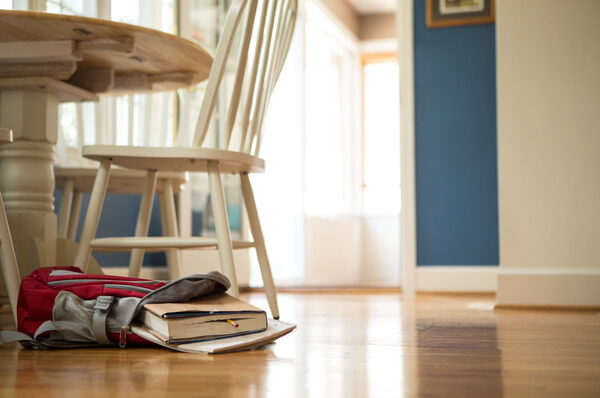
Hardwood floors have the potential to last a lifetime, if properly cleaned and maintained. Dirt from frequent foot traffic or hair, fur and debris from pets can make the floors more slippery and a safety hazard to walk on. Hardwood floors in higher-traffic areas can be more prone to wear and tear. Follow these tips to keep your hardwood floors shiny and safe.
How often should you clean hardwood floors?
A light cleaning of hardwood floors, such as sweeping, vacuuming or dusting, should happen daily (or weekly, at the longest). Spills should be cleaned immediately. The general rule for deep cleaning hardwood floors is wet clean them every 1 to 2 months with a cleanser that is specifically for wood surfaces. This can vary depending on the amount of foot traffic your floors get.1
Daily cleaning for hardwood floors
The best way to take care of your hardwood floors is to develop a regular cleaning routine. For light cleaning that happens daily or more regularly, use a broom or mop to dust while preventing scratches. Vacuum at least once a week using the “hard floor” setting, which uses only suction to clean and prevents scratches on the surface.2
The best way to sweep hardwood floors
Sweeping is a great option to clean your hardwood floors because there is no risk of scratching the floor. Other advantages of brooms are that they don’t require any maintenance, they are a more economical option, they don’t need a lot of storage space and they can reach the gaps between small spaces, such as between the cabinets and under the stove. It’s recommended to sweep daily, checking under any area rugs regularly to remove any dirt and crumbs that can wear down your floor’s finish.3
Can you vacuum hardwood floors?
If you need a slightly deeper clean than just sweeping with a broom, it’s recommended that you vacuum your hardwood floors. To prevent scratching when you vacuum, make sure you use a floor-brush attachment, not a beater bar attachment. You’ll need to vacuum at least once a week, depending on the amount of foot traffic on your floors.4
How to deep clean hardwood floors
It’s great to sweep and vacuum to clean off the dust and dirt on the surface of your hardwood floors, but if you want a deeper clean, it’s recommended to mop your floors. Use a cleaning pad, warm water, and liquid solution to clean the surface. Avoid using too much liquid and leaving the floors damp. If this happens, just use a dry cleaning pad to sop up the excess water.5
Choose a hardwood floor cleaner
When choosing a cleaner, avoid solutions that use harsh chemicals such as chlorine, bleach, ammonia, pine oil or vinegar. Pick a cleaner formulated for your type of wood floor. Using an inappropriate cleanser can damage or dull the polyurethane that seals your floor, so do your research and choose wisely.6
Wet mopping hardwood floors
Start by saturating your mop in your water solution, then wring it out so it’s damp to the touch. Mop the whole hardwood surface, being careful not to leave standing water. If required by the type of cleaning product you’re using, rinse the floor with your water-dampened mop. Next, double-check and clean up any excess liquid. Finally, you can turn on a ceiling fan or air conditioner to speed up the drying process.7
Clean excess fluid
As mentioned before, beware of any excess standing water when mopping your hardwood floors. It’s not guaranteed, but it has the potential to damage the finish of your floors. You can always use paper towels or a cloth towel to soak up any excess liquid on the surface.7
Remove stains from hardwood floors
If you notice a dark spot or pet stain on your hardwood floor, rub the spot with very fine-grade steel wool and floor wax. If that doesn’t work, try applying diluted bleach or vinegar and allow time to soak. Monitor and rinse with a damp cloth. Let the spot dry and keep any children or pets out of the room until you’re finished.7
Maintain hardwood floors
If you want your hardwood floors to look their best between cleanings, here are a few tips that you can follow:
- Use door mats, area rugs, or runners in high-traffic areas to keep dirt off your floors and help prevent wear and tear.
- Use furniture pads on the legs of chairs, couches, and tables to prevent deep scratches.
- Use furniture sliders when rearranging the furniture in a room to protect your floors and make it easier to move heavy objects.
- Don’t wear heavy shoes or high heels, as some shoes can cause dents and scuffs.
- Clean up spills as soon as possible, then dry the area to prevent stains.2
While you’re spring cleaning your house, you might as well tackle those hardwood floors with a deep cleaning. Don’t have hardwood floors? With Nationwide Insurance, you might be covered for some home renovations.
Sources:
[1] “How to Clean Hardwood Floors the Right Way,” goodhousekeeping.com/home/cleaning/tips/a19631/maintaining-wood-floors (Accessed Jan. 23, 2020).
[2] “How to Clean Hardwood Floors,” homedepot.com/c/ah/how-to-clean-hardwood-floors (Accessed April 6, 2023).
[3] “Should You Sweep or Vacuum the Hardwood Floor?” spicandspan.de/blog/should-you-sweep-or-vacuum-the-hardwood-floor (Accessed April 6, 2023).
[4] “How to Clean Hardwood Floors,” hgtv.com/lifestyle/clean-and-organize/how-to-clean-hardwood-floors (Accessed April 6, 2023).
[5] “How To Deep Clean Hardwood Floors To Keep Them Looking Their Best,” southernliving.com/how-to-deep-clean-hardwood-floors (Accessed Jan. 19, 2023).
[6] “The Ultimate Guide to Cleaning and Protecting Your Wood Flooring: Tips, Tricks, and Best Practices,” coit.com/blog/general-home-cleaning/ultimate-guide-cleaning-and-protecting-your-wood-flooring-tips-tricks (Accessed Jan. 25, 2023).
[7] “How to Clean Wood Floors and Remove Stains for a Polished Look,” bhg.com/homekeeping/house-cleaning/surface/how-to-clean-hardwood-floors (Accessed April 6, 2023).
Disclaimer:
The information included here is designed for informational purposes only. It is not legal, tax, financial or any other sort of advice, nor is it a substitute for such advice. The information may not apply to your specific situation. We have tried to make sure the information is accurate, but it could be outdated or even inaccurate in parts. It is the reader’s responsibility to comply with any applicable local, state or federal regulations. Nationwide Mutual Insurance Company, its affiliates and their employees make no warranties about the information nor guarantee of results, and they assume no liability in connection with the information provided. Nationwide and the Nationwide N and Eagle are service marks of Nationwide Mutual Insurance Company. © 2023 Nationwide



